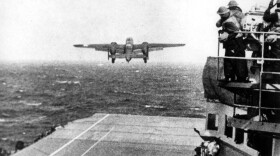A rare Dornier 17, an aluminum-skinned German bomber that flew in the Battle of Britain, has been salvaged from the murky waters of the English Channel. The plane was shot down more than 70 years ago near the coast of Kent.
"The Royal Air Force Museum is pleased to announce the successful lift of the only known example of the Dornier Do17," said the RAF Museum's director general, Peter Dye, Monday. He called the feat an "incredibly complex and delicate operation."
A salvage team succeeded in bringing up most of the plane in one large piece, using a crane and cables that had been carefully attached to the plane's frame.
"Flying for the first time in 70 years, and probably actually for the last time in its life, it's just come out of the English Channel," the BBC's Nick Higham said in a video report, filmed from the deck of the salvage barge during Monday afternoon's work.
The wreck was first spotted by a diver in 2008. In recent weeks, attempts to raise the Do 17 were delayed repeatedly due to bad weather.
Eventually, the salvage team was forced to abandon its plan of assembling a frame around the craft; instead, divers attached cables and hoists to "specific points on the aircraft that the Museum have identified as the strongest parts of the airframe," according to the RAF Museum site.
The plane is covered in barnacles and other sea growth, but its fuselage is largely intact, as are large portions of its wings. Two propellers were also brought up Monday, during a tight two-and-a-half-hour timeframe that was dictated by winds and tides.
A medium-range bomber, the Dornier 17 was used often in the early days of World War II.
"The twin engine, twin fin configuration together with the narrow fuselage and shoulder-mounted engines gave the aircraft a distinctive silhouette and earned it the nickname 'The Flying Pencil,'" the RAF Museum says.
Eventually, many Do 17s were stripped down for their metal content — the planes were made almost entirely of aluminum, with chromium-molybdenum steel sections bolstering the wing assembly.
It will take at least two years to restore the craft, the BBC reports, before it is put on display at the RAF Museum in Cosford.
Copyright 2020 NPR. To see more, visit https://www.npr.org. 9(MDAxNDQ2NDAxMDEyNzU2NzM2ODA3ZGI1ZA001))





